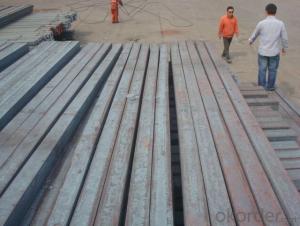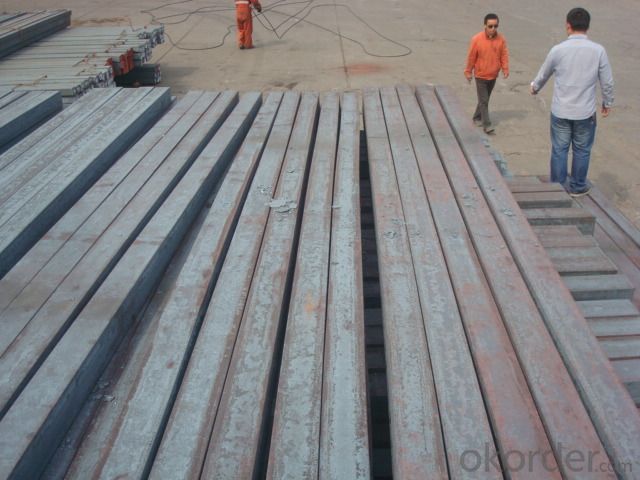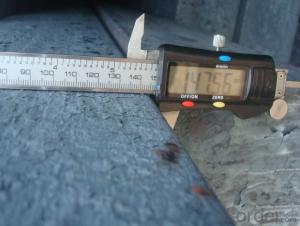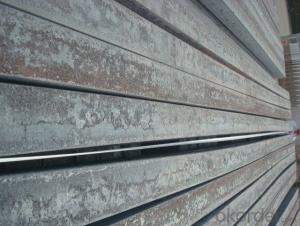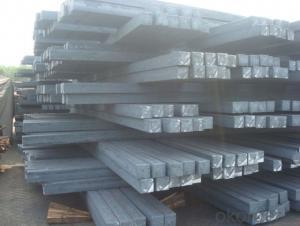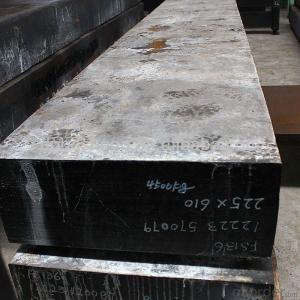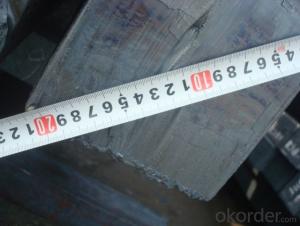Steel Billet/Bloom Manufactured by Continue Casting Blast Furnace
- Loading Port:
- Tianjin
- Payment Terms:
- TT OR LC
- Min Order Qty:
- 1000 m.t.
- Supply Capability:
- 10000 m.t./month
OKorder Service Pledge
OKorder Financial Service
You Might Also Like
Steel Billet/Bloom Manufactured by Continue Casting Blast Furnace
1.Structure of Steel Billet/Bloom Manufactured by Continue Casting Blast Furnace
Continue Casting Steel Billet Manufactured By Blasting Furnace is the raw material of all kinds of steel mill. Billet section of square, round, flat, rectangular and abnormity, etc Several, mainly related to shape of rolled products. Simple rolled section steel, choose cross section of square billet or rectangular billet. rolling The sector products such as flat steel, Angle steel, select the rectangular billet or slab. Had better profiled billet when production beams, channels, and in rolling process Lines and improve the yield. The raw material of round billet is the production of seamless tube.
2.Main Features of Steel Billet/Bloom Manufactured by Continue Casting Blast Furnace.
Continue Casting Steel Billet Manufactured By Blasting Furnace section size should meet the requirements of rolling deformation and finished product quality, but also roll strength and biting condition of restrictions. General steel Billet section height H. And the roll diameter D The ratio of the ( namely H/D) Should be less than or equal to zero 0.5 . Length of steel billet by finishing temperature, Rolling time and the length of the product Or times ruler. When heated too long accident prone to bump the furnace wall of steel, too short, furnace bottom utilization rate is not high, influence the heating furnace production. For the production Choose a variety of steel and steel billet, should consider the affinities of billet, as far as possible in order to improve the productivity of the roughing mill, simplify the stock management of workshop.
There are three shapes of the steel billets: square billet, slab, rectangular billet The Chinese billet, rectangular billet is mainly suitable for rolling hot rolled strip, building reinforced bar, Ordinary wire, high speed wire rod and various small profile. Of the slab are mainly used for rolling plate and hot coil sheet.
3. Steel Billet/Bloom Manufactured by Continue Casting Blast Furnace Images
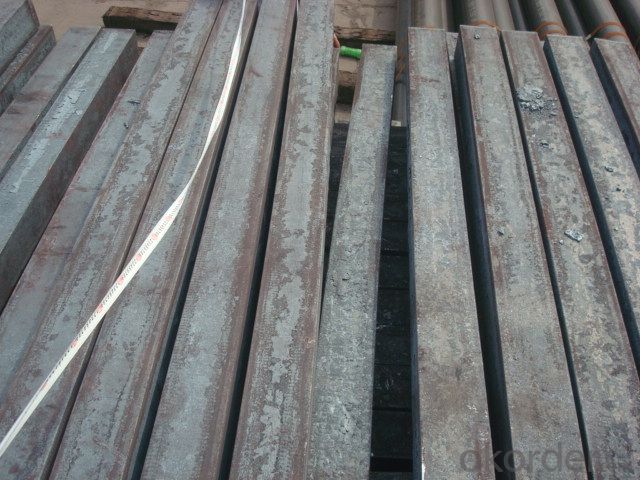
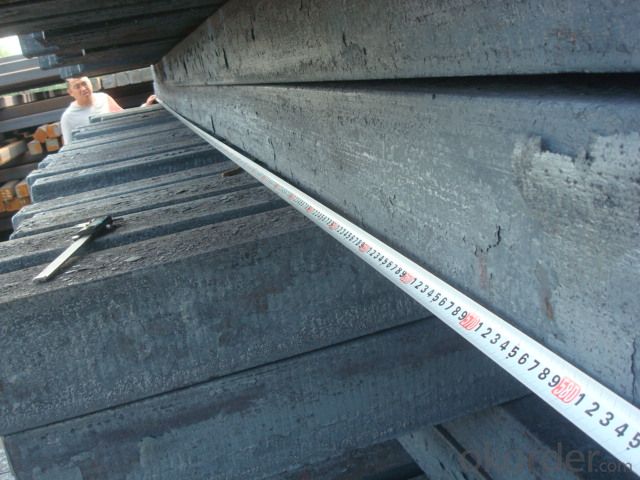
4. Steel Billet/Bloom Manufactured by Continue Casting Blast Furnace Specification
Continue Casting Steel Billet Manufactured By Blasting Furnace rolled steel, after processing can be used for mechanical parts, forging parts, processing all kinds of steel, steel Q345B channel steel, wire rod is the role of the billet. Steel billet is used in the production of semi-finished products, generally cannot be used directly for the society. Steel billets and steel are strictly divided into standard, cannot decide to whether the business enterprise of the final product, and according to unified standards to perform the whole society. Typically, billet and the steel is relatively easy to distinguish, but for some steel billet, and have the same specification and same steel purposes (such as rolling tube billet), whether can be used for other industries, whether through steel processing process, whether through a finished product rolling mill processing to distinguish
Material standard The editor Range of thickness: 150-240 - mm + / - 5 mm width range: 880-1530 - mm + / - 20 mm Length: 3700-10000 - mm + / - 500 - mm Cross-sectional size: 64 * 64; 82 * 82; 98 * 98; 124 * 124; 120 * 150; 152 * 164; 152 * 170 mm Length: 9000 mm Section of tolerance: billet: 1.0 + / - 2.0-1.0 + / - 1.0 mm slab: width: + / - 2.0 mm thickness: + / - 3.0 mm The length tolerance: + / - 200 mm Section diagonal tolerance: 3.5-8.0 MM Billet section size protrusions requirements: < 1242 mm, do not allow; > = 1242 mm, < = 2 mm 1242 mm, < = 3 mm Beheading (shear) extension deformation: < 1242 mm billet: no control; The slab: < = 15 mm Surface tilt: no more than billet section 0.1 Bending: every 1 m length is not more than 10 mm The distortion: length < = 5 m, < = 11. ; The length of the < = 7.5 M, < = 5. Material % 3 sp/PS chemical composition: C Mn Si S P
5.FAQ of Steel Billet/Bloom Manufactured by Continue Casting Blast Furnace
We have organized several common questions for our clients,may help you sincerely:
①How about your company?
A world class manufacturer & supplier of castings forging in carbon steel and alloy steel,is one of the large-scale professional investment casting production bases in China,consisting of both casting foundry forging and machining factory. Annually more than 8000 tons Precision casting and forging parts are exported to markets in Europe,America and Japan. OEM casting and forging service available according to customer’s requirements.
②How to guarantee the quality of the products?
We have established the international advanced quality management system,every link from raw material to final product we have strict quality test;We resolutely put an end to unqualified products flowing into the market. At the same time, we will provide necessary follow-up service assurance.
③What is the advantage of the continue Casting steel billet comparing to the die casting steel billet?
Compared with die casting, continuous casting has the advantages of: 1. To simplify the Steel billet The production process 2. Improve the metal yield 3. Improve the quality of the billet 4. Reduces the steel worker's labor intensity 5. Save energy and reduce consumption
- Q: What are the dimensions of a typical steel billet?
- The dimensions of a typical steel billet can vary depending on its intended use and the specific manufacturing process. However, generally speaking, steel billets usually have a rectangular shape with widths ranging from 100mm to 300mm, heights ranging from 100mm to 400mm, and lengths ranging from 6m to 12m. These dimensions allow for easy handling and transportation, as well as flexibility in shaping and forming the steel billet into various end products like bars, rods, or sheets. It's worth noting that these dimensions are not set in stone and can be tailored to meet the specific requirements of the production process or the customer's preferences.
- Q: Can steel billets be painted or coated for decorative purposes?
- Steel billets can indeed be painted or coated to achieve decorative purposes. By painting or coating steel billets, not only is their appearance improved, but they are also safeguarded against corrosion and other environmental factors. A variety of paints and coatings, including epoxy, powder coating, and metallic finishes, can be utilized to achieve the desired decorative effect. These coatings can be applied to steel billets using methods such as spray painting, electrostatic coating, or hot-dipping. To ensure a strong bond and long-lasting decorative finish, it is crucial to properly prepare the surface of the steel billets before applying the paint or coating.
- Q: What is the typical size and shape of steel billets?
- The typical size and shape of steel billets can vary depending on the specific application and industry requirements. However, they are commonly rectangular or square in shape, with dimensions ranging from a few inches to several feet in length, width, and height.
- Q: How do steel billets contribute to the manufacturing of renewable energy equipment?
- Steel billets play a significant role in the manufacturing of renewable energy equipment. These billets, which are semi-finished metal products, are used as raw materials in the production of various components and structures that are essential for renewable energy systems. Firstly, steel billets are used in the construction of wind turbines. The towers that support the wind turbines are typically made of steel, and these towers require large quantities of steel billets to be manufactured. The billets are used to create the tower sections, which are then assembled to form the tall structures that hold the wind turbines. Additionally, steel billets are also used for the production of other wind turbine components such as rotor hubs and nacelles, which house the generator and other crucial parts of the turbine. Furthermore, steel billets are instrumental in the manufacturing of solar energy equipment. Solar panels, which harness sunlight to generate electricity, rely on steel structures to support and secure the panels. Steel billets are used to construct the frames and mounting systems that hold the solar panels in place, ensuring their stability and longevity. These steel structures are crucial in enabling solar panels to be installed on various surfaces such as rooftops, fields, and even floating platforms. In addition to wind turbines and solar panels, steel billets are utilized in the production of other renewable energy equipment as well. For instance, hydroelectric power plants require steel components such as penstocks, which are large pipes that carry water to the turbines, and steel billets are used in their manufacturing. Similarly, steel billets are used in the construction of biomass power plants, where they are utilized to create the structures that house the biomass boilers and generators. Overall, steel billets are vital in the manufacturing of renewable energy equipment, as they are used to create the structures, components, and supports that are necessary for the functioning of wind turbines, solar panels, hydroelectric power plants, and biomass power plants. The use of steel billets ensures the durability, strength, and reliability of these renewable energy systems, thus contributing to the growth and success of the renewable energy sector as a whole.
- Q: What are the different types of straightening methods used for steel billets?
- There are several different types of straightening methods used for steel billets, depending on the specific requirements and desired outcome. These methods include: 1. Roller Straightening: This method involves passing the steel billets through a series of rollers that apply pressure in various directions to straighten them. The rollers can be adjusted to apply more pressure on certain areas of the billet that may be bent or twisted. 2. Hydraulic Straightening: In this method, hydraulic presses are used to apply pressure on the billets, either in a single direction or in multiple directions. The pressure can be adjusted to achieve the desired level of straightness. 3. Heat Straightening: Heat straightening is a method that involves applying heat to the bent or twisted areas of the steel billets and then using hydraulic or mechanical tools to straighten them. The heat softens the steel, allowing it to be reshaped more easily. 4. Hammering: Hammering is a traditional method of straightening steel billets, where skilled workers use hammers and anvils to manually reshape the billets. This method requires a high level of skill and precision to achieve the desired straightness. 5. Magnetic Straightening: Magnetic straightening is a non-contact method that uses magnetic fields to apply forces on the steel billets and straighten them. This method is often used for smaller and thinner billets, where other methods may cause damage or distortion. Each of these straightening methods has its own advantages and limitations, and the choice of method depends on factors such as the size and thickness of the billets, the degree of straightness required, and the available equipment and resources.
- Q: What is the average weight of a steel billet?
- The size and dimensions of a steel billet can cause variations in its average weight. Nevertheless, a standard steel billet generally ranges from 1,000 kilograms (2,204 pounds) to 5,000 kilograms (11,023 pounds). These weight ranges are commonly observed in industrial-grade steel billets utilized in diverse manufacturing techniques like forging, rolling, and extrusion. It should be emphasized that the weight of a steel billet can be tailored according to specific necessities and industry norms.
- Q: What are the main surface finishes available for steel billets?
- The main surface finishes available for steel billets include mill finish, pickled and oiled (P&O), galvanized, painted, and coated finishes. Mill finish refers to the surface of the steel billet as it comes from the rolling mill, which is typically characterized by a rough and unfinished appearance. This finish is suitable for applications where aesthetics are not a priority, such as when the billets will be further processed or coated. Pickled and oiled (P&O) finish involves treating the steel billets with an acid solution to remove any mill scale or impurities, followed by applying a thin layer of oil to protect the surface from oxidation. This finish provides a clean and smooth surface, making it suitable for applications where a high-quality appearance is desired. Galvanized finish involves immersing the steel billets in a zinc bath to create a protective layer of zinc coating over the surface. This finish provides excellent corrosion resistance, making it ideal for outdoor applications or environments with high moisture or chemical exposure. Painted finish involves applying a layer of paint onto the surface of the steel billets. This finish offers both aesthetic appeal and protection against corrosion, as the paint acts as a barrier between the steel and the external environment. Painted finishes can be customized in terms of color and texture to suit specific requirements. Coated finishes involve applying a specialized coating onto the surface of the steel billets. These coatings can include epoxy, polyurethane, or other protective materials that provide enhanced corrosion resistance, chemical resistance, or heat resistance. Coated finishes are often used in industries such as automotive, construction, or oil and gas, where the billets are subjected to harsh conditions. Overall, the choice of surface finish for steel billets depends on the specific application requirements, including aesthetics, corrosion resistance, durability, and environmental factors.
- Q: What are the main challenges in the storage of steel billets?
- The main challenges in the storage of steel billets include maintaining proper environmental conditions, managing space efficiently, ensuring safety measures, preventing corrosion, and minimizing material damage. Firstly, the storage area should be maintained at a controlled temperature and humidity to prevent the steel billets from being exposed to extreme weather conditions, which could lead to rusting, oxidation, or other forms of corrosion. Adequate ventilation is also necessary to prevent the buildup of moisture that could affect the quality of the billets. Secondly, managing space efficiently is crucial in steel billet storage. Billets are often stored in large quantities, so proper organization and stacking methods must be employed to maximize the storage capacity and facilitate easy access to individual billets when needed. Implementing effective inventory management systems can help prevent unnecessary handling and potential damage. Safety measures are another significant challenge in steel billet storage. Due to their heavy weight and potential for sharp edges, it is essential to ensure proper handling and storage procedures to avoid accidents or injuries. Adequate training for personnel and the use of appropriate lifting equipment are necessary to maintain a safe working environment. Corrosion prevention is a critical concern in steel billet storage. Applying protective coatings, such as oil or rust inhibitors, can help shield the billets from moisture and prevent oxidation. Regular inspections and maintenance routines are also necessary to identify and address any signs of corrosion promptly. Lastly, minimizing material damage is crucial in steel billet storage. Proper handling techniques, such as avoiding dropping or dragging the billets, should be followed to prevent deformation or surface damage. Using suitable packaging or padding materials during transportation and storage can also help protect the billets from scratches or other physical impacts. In conclusion, the main challenges in the storage of steel billets revolve around maintaining proper environmental conditions, efficient space management, ensuring safety measures, preventing corrosion, and minimizing material damage. By addressing these challenges effectively, the longevity and quality of the steel billets can be preserved, resulting in enhanced operational efficiency and customer satisfaction.
- Q: Reasons and treatment methods of billet stripping in continuous casting
- even two cold regions can be uniformly cooled, due to uneven thickness of shell, caused by the inconsistent temperature, the shell shrinkage is still uneven, and also there will be the development of. Therefore, the selection of unqualified mold is the main reason causing the removal. Secondly, the cooling effect of the two cooling zone can not be ignored.
- Q: What are the different heat treatment processes applied to steel billets?
- There are several different heat treatment processes that can be applied to steel billets, depending on the desired properties and characteristics of the final product. Some of the most common heat treatment processes used for steel billets include: 1. Annealing: This process involves heating the steel billets to a high temperature and then slowly cooling them, usually in a controlled atmosphere or furnace. Annealing helps to relieve internal stresses, improve machinability, and enhance the steel's ductility and toughness. 2. Normalizing: Normalizing is a heat treatment process that involves heating the steel billets to a temperature above the critical range and then allowing them to cool in still air. This process helps to refine the grain structure, improve the mechanical properties, and enhance the machinability of the steel. 3. Quenching: Quenching is a rapid cooling process that involves immersing the steel billets in a quenching medium, such as water, oil, or polymer, after they have been heated to a high temperature. This process creates a hardened and stronger steel with improved wear resistance, but it may also result in increased brittleness. 4. Tempering: Tempering is a heat treatment process that follows quenching and involves reheating the hardened steel billets to a specific temperature and then cooling them in still air. This process helps to relieve residual stresses, reduce brittleness, and improve the toughness and ductility of the steel. 5. Austempering: Austempering is a heat treatment process that involves quenching the steel billets in a bath of molten salt or other medium at a temperature just above the critical range, followed by holding them at that temperature until the desired transformation occurs. Austempering produces a steel with high strength, improved ductility, and reduced distortion. 6. Martempering: Martempering is a quenching process similar to austempering, but with a shorter holding time at the quenching temperature. This process results in a steel with a combination of high strength and toughness, as well as reduced distortion. 7. Case hardening: Case hardening is a heat treatment process that involves adding carbon to the surface layer of the steel billets, typically through carburizing or nitriding. This process forms a hardened case with increased wear resistance, while maintaining a more ductile core. These are just a few examples of the heat treatment processes that can be applied to steel billets. The specific process used will depend on the desired properties of the final product and the type of steel being treated.
Send your message to us
Steel Billet/Bloom Manufactured by Continue Casting Blast Furnace
- Loading Port:
- Tianjin
- Payment Terms:
- TT OR LC
- Min Order Qty:
- 1000 m.t.
- Supply Capability:
- 10000 m.t./month
OKorder Service Pledge
OKorder Financial Service
Similar products
Hot products
Hot Searches
Related keywords
